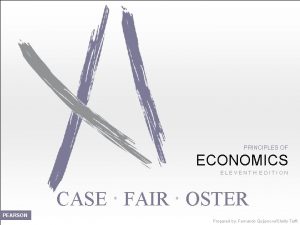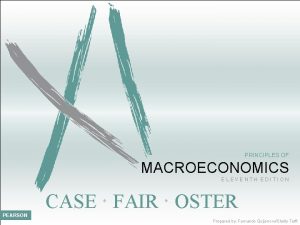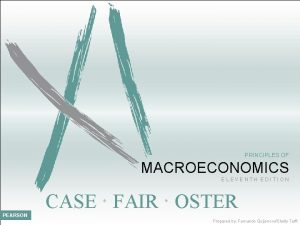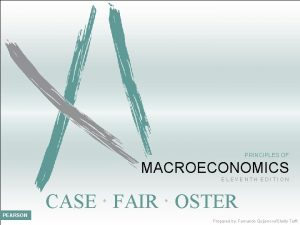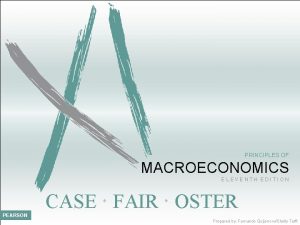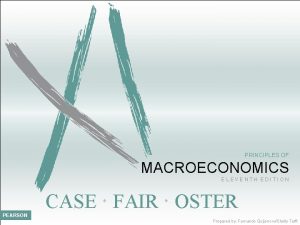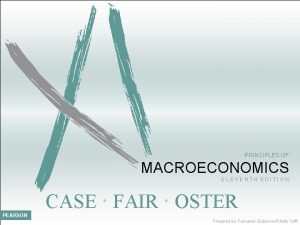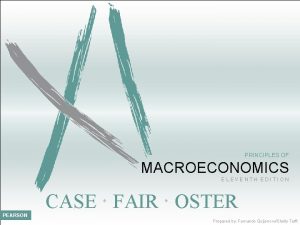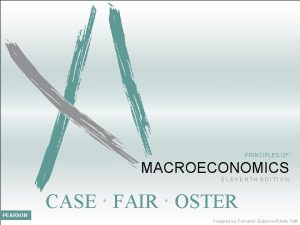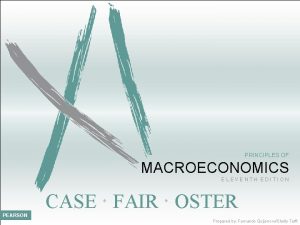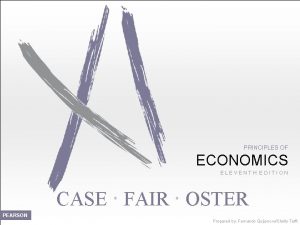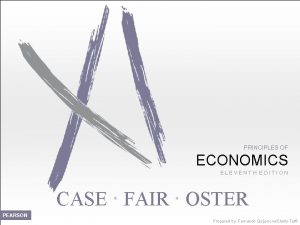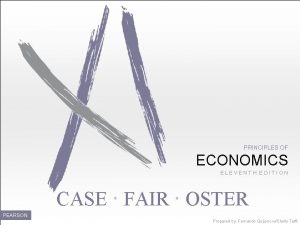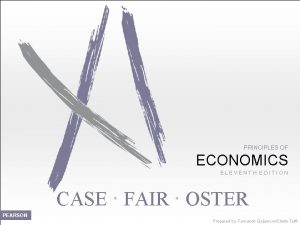PRINCIPLES OF MACROECONOMICS ELEVENTH EDITION CASE FAIR OSTER























- Slides: 23

PRINCIPLES OF MACROECONOMICS ELEVENTH EDITION CASE FAIR OSTER PEARSON Prepared by: Fernando Quijano w/Shelly Tefft

Unemployment, Inflation, and Long-Run Growth 7 CHAPTER OUTLINE Unemployment Measuring Unemployment Components of the Unemployment Rate The Costs of Unemployment Inflation The Consumer Price Index The Costs of Inflation Long-Run Growth Output and Productivity Growth Looking Ahead © 2014 Pearson Education, Inc. 2 of 27

Unemployment Measuring Unemployment employed Any person 16 years old or older (1) who works for pay, either for someone else or in his or her own business for 1 or more hours per week, (2) who works without pay for 15 or more hours per week in a family enterprise, or (3) who has a job but has been temporarily absent with or without pay. unemployed A person 16 years old or older who is not working, is available for work, and has made specific efforts to find work during the previous 4 weeks. © 2014 Pearson Education, Inc. 3 of 27

not in the labor force A person who is not looking for work because he or she does not want a job or has given up looking. labor force The number of people employed plus the number of unemployed. labor force = employed + unemployed population = labor force + not in labor force © 2014 Pearson Education, Inc. 4 of 27

unemployment rate The ratio of the number of people unemployed to the total number of people in the labor force participation rate The ratio of the labor force to the total population 16 years old or older. © 2014 Pearson Education, Inc. 5 of 27

TABLE 7. 1 Employed, Unemployed, and the Labor Force, 1950– 2012 (1) Population 16 Years Old or Over (Millions) (2) Labor Force (Millions) (3) (4) (5) (6) Employed (Millions) Unemployed (Millions) Labor Force Participation Rate (Percentage Points) Unemployment Rate (Percentage Points) 1950 105. 0 62. 2 58. 9 3. 3 59. 2 5. 3 1960 117. 2 69. 6 65. 8 3. 9 59. 4 5. 5 1970 137. 1 82. 8 78. 7 4. 1 60. 4 4. 9 1980 167. 7 106. 9 99. 3 7. 6 63. 8 7. 1 1990 189. 2 125. 8 118. 8 7. 0 66. 5 5. 6 2000 212. 6 142. 6 136. 9 5. 7 67. 1 4. 0 2012 243. 3 155. 0 142. 5 12. 5 63. 7 8. 1 Note: Figures are civilian only (military excluded). © 2014 Pearson Education, Inc. 6 of 27

Components of the Unemployment Rates for Different Demographic Groups TABLE 7. 2 Unemployment Rates by Demographic Group, 1982 and 2012 Years Total White Men Women Both sexes African American Men Women Both sexes © 2014 Pearson Education, Inc. 20+ 20+ 16– 19 November 1982 December 2012 10. 8 9. 6 9. 0 8. 1 21. 3 20. 2 19. 3 16. 5 49. 5 7. 8 6. 9 6. 2 6. 3 21. 6 14. 0 12. 2 40. 5 7 of 27

Unemployment Rates in States and Regions TABLE 7. 3 Regional Differences in Unemployment, 1975, 1982, 1991, 2003 and 2010 U. S. avg. Cal. Fla. Ill. Mass. Mich. N. J. N. Y. N. C. Ohio Tex. © 2014 Pearson Education, Inc. 1975 8. 5 9. 9 10. 7 7. 1 11. 2 12. 5 10. 2 9. 5 8. 6 9. 1 5. 6 1982 9. 7 9. 9 8. 2 11. 3 7. 9 15. 5 9. 0 8. 6 9. 0 12. 5 6. 9 1991 6. 7 7. 5 7. 3 7. 1 9. 0 9. 2 6. 6 7. 2 5. 8 6. 4 6. 6 2003 6. 0 6. 7 5. 1 6. 7 5. 8 7. 3 5. 9 6. 3 6. 5 6. 1 6. 8 2010 9. 6 12. 4 11. 5 10. 3 8. 5 12. 5 9. 5 8. 6 10. 1 8. 2 8 of 27

Discouraged-Worker Effects discouraged-worker effect The decline in the measured unemployment rate that results when people who want to work but cannot find jobs grow discouraged and stop looking, thus dropping out of the ranks of the unemployed and the labor force. The BLS survey provides some evidence on the size of the discouraged-worker effect. Respondents who indicate that they have stopped searching for work are asked why they stopped. If the respondent cites inability to find employment as the sole reason for not searching, that person might be classified as a discouraged worker. Some economists argue that adding the number of discouraged workers to the number who are now classified as unemployed gives a better picture of the unemployment situation. © 2014 Pearson Education, Inc. 9 of 27

The Duration of Unemployment TABLE 7. 4 Average Duration of Unemployment, 1970– 2012 1970 1971 1972 1973 1974 1975 1976 1977 1978 1979 1980 1981 1982 1983 1984 Weeks 8. 6 11. 3 12. 0 10. 0 9. 8 14. 2 15. 8 14. 3 11. 9 10. 8 11. 9 13. 7 15. 6 20. 0 18. 2 © 2014 Pearson Education, Inc. 1985 1986 1987 1988 1989 1990 1991 1992 1993 1994 1995 1996 1997 1998 1999 Weeks 15. 6 15. 0 14. 5 13. 5 11. 9 12. 0 13. 7 17. 7 18. 0 18. 8 16. 6 16. 7 15. 8 14. 5 13. 4 2000 2001 2002 2003 2004 2005 2006 2007 2008 2009 2010 2011 2012 Weeks 12. 6 13. 1 16. 6 19. 2 19. 6 18. 4 16. 8 17. 9 24. 4 33. 0 39. 3 39. 4 10 of 27

The Costs of Unemployment Some Unemployment Is Inevitable When we consider the various costs of unemployment, it is useful to categorize unemployment into three types: Frictional unemployment Structural unemployment Cyclical unemployment © 2014 Pearson Education, Inc. 11 of 27

Frictional, Structural, and Cyclical Unemployment frictional unemployment The portion of unemployment that is due to the normal turnover in the labor market; used to denote short-run job/skill-matching problems. structural unemployment The portion of unemployment that is due to changes in the structure of the economy that result in a significant loss of jobs in certain industries. natural rate of unemployment The unemployment rate that occurs as a normal part of the functioning of the economy. Sometimes taken as the sum of the frictional unemployment rate and the structural unemployment rate. cyclical unemployment Unemployment that is above frictional plus structural unemployment. © 2014 Pearson Education, Inc. 12 of 27

Social Consequences The costs of unemployment are neither evenly distributed across the population nor easily quantified. The social consequences of the Depression of the 1930 s are perhaps the hardest to comprehend. Few emerged from this period unscathed. At the bottom were the poor and the fully unemployed, about 25 percent of the labor force. Even those who kept their jobs found themselves working part-time. Many people lost all or part of their savings as the stock market crashed and thousands of banks failed. © 2014 Pearson Education, Inc. 13 of 27

Inflation The Consumer Price Index consumer price index (CPI) A price index computed each month by the Bureau of Labor Statistics using a bundle that is meant to represent the “market basket” purchased monthly by the typical urban consumer. producer price indexes (PPIs) Measures of prices that producers receive for products at all stages in the production process. Once called wholesale price indexes, PPIs are calculated separately for various stages in the production process. The three main categories are finished goods, intermediate materials, and crude materials, although there are subcategories within each of these categories. © 2014 Pearson Education, Inc. 14 of 27

▲ FIGURE 7. 1 The CPI Market Basket The CPI market basket shows how a typical consumer divides his or her money among various goods and services. The CPI market basket for December 2007 shows that most of a consumer’s money goes toward housing, transportation, and food and beverages. © 2014 Pearson Education, Inc. 15 of 27

TABLE 7. 5 The CPI, 1950– 2012 1950 1951 1952 1953 1954 1955 1956 1957 1958 1959 1960 1961 1962 1963 1964 1965 1966 1967 1968 1969 1970 Percentage Change in CPI 1. 3 7. 9 1. 9 0. 8 0. 7 -0. 4 1. 5 3. 3 2. 8 0. 7 1. 0 1. 3 1. 6 2. 9 3. 1 4. 2 5. 5 5. 7 © 2014 Pearson Education, Inc. CPI 24. 1 26. 0 26. 5 26. 7 26. 9 26. 8 27. 2 28. 1 28. 9 29. 1 29. 6 29. 9 30. 2 30. 6 31. 0 31. 5 32. 4 33. 4 34. 8 36. 7 38. 8 1971 1972 1973 1974 1975 1976 1977 1978 1979 1980 1981 1982 1983 1984 1985 1986 1987 1988 1989 1990 1991 Percentage Change in CPI 4. 4 3. 2 6. 2 11. 0 9. 1 5. 8 6. 5 7. 6 11. 3 13. 5 10. 3 6. 2 3. 2 4. 3 3. 6 1. 9 3. 6 4. 1 4. 8 5. 4 4. 2 CPI 40. 5 41. 8 44. 4 49. 3 53. 8 56. 9 60. 6 72. 6 65. 2 82. 4 90. 9 96. 5 99. 6 103. 9 107. 6 109. 6 113. 6 118. 3 124. 0 130. 7 136. 2 1993 1994 1995 1996 1997 1998 1999 2000 2001 2002 2003 2004 2005 2006 2007 2008 2009 2010 2011 2012 Percentage Change in CPI 3. 0 2. 6 2. 8 3. 0 2. 3 1. 6 2. 2 3. 4 2. 8 1. 6 2. 3 2. 7 3. 4 3. 2 2. 8 3. 9 -0. 4 1. 7 3. 1 2. 1 CPI 140. 3 144. 5 148. 2 152. 4 156. 9 160. 5 163. 0 166. 6 172. 2 177. 1 179. 9 184. 0 188. 9 195. 3 201. 6 207. 3 215. 3 214. 5 218. 1 224. 9 229. 6 16 of 27

The Costs of Inflation During inflations, most prices—including input prices like wages—tend to rise together, and input prices determine both the incomes of workers and the incomes of owners of capital and land. So inflation by itself does not necessarily reduce ones purchasing power. Inflation May Change the Distribution of Income One way of thinking about the effects of inflation on the distribution of income is to distinguish between anticipated and unanticipated inflation. The effects of anticipated inflation on the distribution of income are likely to be fairly small, since people and institutions will adjust to the anticipated inflation. Unanticipated inflation, on the other hand, may have large effects, depending, among other things, on how much indexing to inflation there is. real interest rate The difference between the interest rate on a loan and the inflation rate. © 2014 Pearson Education, Inc. 17 of 27

Administrative Costs and Inefficiencies There may be costs associated even with anticipated inflation, such as the administrative cost associated with simply keeping up. Interest rates tend to rise with anticipated inflation. When interest rates are high, the opportunity costs of holding cash outside of banks is high. Public Enemy Number One? Economists have debated the seriousness of the costs of inflation for decades. No matter what its real economic cost, it makes us uneasy and unhappy. In 1974, President Ford verbalized some of this discomfort when he said, “Our inflation, our public enemy number one, will unless whipped destroy our country, our homes, our liberties, our property, and finally our national pride, as surely as any well-armed wartime enemy. ” In this belief, our elected leaders have vigorously pursued policies designed to stop inflation. © 2014 Pearson Education, Inc. 18 of 27

Long-Run Growth output growth The growth rate of the output of the entire economy. per-capita output growth The growth rate of output person in the economy. productivity growth The growth rate of output per worker. © 2014 Pearson Education, Inc. 19 of 27

Output and Productivity Growth ▲ FIGURE 7. 2 Output per Worker Hour (Productivity), 1952 I– 2012 IV Productivity grew much faster in the 1950 s and 1960 s than it has since. © 2014 Pearson Education, Inc. 20 of 27

▲ FIGURE 7. 3 Capital per Worker, 1952 I– 2012 IV Capital per worker grew until about 1980 and then leveled off somewhat. © 2014 Pearson Education, Inc. 21 of 27

Looking Ahead This ends our introduction to the basic concepts and problems of macroeconomics. The first chapter of this part introduced the field; the second chapter discussed the measurement of national product and national income; and this chapter discussed unemployment, inflation, and long-run growth. We are now ready to begin the analysis of how the macroeconomy works. © 2014 Pearson Education, Inc. 22 of 27

REVIEW TERMS AND CONCEPTS consumer price index (CPI) productivity growth cyclical unemployment real interest rate discouraged-worker effect structural unemployment employed unemployed frictional unemployment rate labor force Equations: labor force participation rate labor force = employed + unemployed natural rate of unemployment population = labor force + not in labor force not in the labor force output growth per-capita output growth producer price indexes (PPIs) © 2014 Pearson Education, Inc. 23 of 27
 Principles of macroeconomics case fair oster
Principles of macroeconomics case fair oster Principles of economics case fair oster
Principles of economics case fair oster Eleventh edition management
Eleventh edition management Management 11th edition by stephen p robbins
Management 11th edition by stephen p robbins Management eleventh edition
Management eleventh edition Management eleventh edition
Management eleventh edition Vicky thorland-oster
Vicky thorland-oster Oster pro 3000
Oster pro 3000 How to become known on twitter
How to become known on twitter Parkin macroeconomics 13th edition pdf
Parkin macroeconomics 13th edition pdf Macroeconomics ninth edition
Macroeconomics ninth edition Bhore committee
Bhore committee Eleventh 5 year plan
Eleventh 5 year plan Eleventh plan
Eleventh plan For his eleventh birthday elvis presley
For his eleventh birthday elvis presley Sonnet with 14 lines
Sonnet with 14 lines Foul is fair and fair is foul literary device
Foul is fair and fair is foul literary device Literary devices macbeth
Literary devices macbeth Foul is fair macbeth
Foul is fair macbeth What is syntax rhetorical device
What is syntax rhetorical device Fair play significado
Fair play significado Examples of fair is foul and foul is fair in macbeth
Examples of fair is foul and foul is fair in macbeth Best case worst case average case
Best case worst case average case Mis chapter 6
Mis chapter 6

